Binngarra
Binngarra was a ferry operated by the Port Jackson Co-operative Steamship Company, which became the Port Jackson & Manly Steamship Company, on the Manly service. Launched in 1905, she was the first of six similar vessels built for the company–the Binngarra class—the success of which saw three of her sister vessels serving through to the 1970s and 1980s.
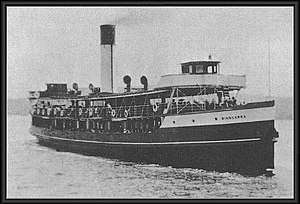 Binngarra on Sydney Harbour | |
| History | |
|---|---|
| Name: | Binngarra |
| Operator: | Port Jackson & Manly Steamship Company |
| Port of registry: | Sydney |
| Route: | Manly |
| Builder: | Mort's Dock and Engineering |
| Cost: | ₤23,564 |
| Launched: | 18 July 1905 |
| Maiden voyage: | 29 October 1905 |
| Out of service: | 1930 |
| Fate: | Scuttled 1 August 1980 |
| General characteristics | |
| Class and type: | Binngarra-class ferry |
| Tonnage: | 442 tons |
| Length: | 58.1 m (190 ft 7 in) |
| Beam: | 9.7 m (31 ft 10 in) |
| Height: | 4.1 m (13 ft 5 in) |
| Draught: | 3.45 m (11 ft 4 in) |
| Decks: | 2 |
| Installed power: | 103 NHP, 1,150 ihp (860 kW) |
| Propulsion: | 3 cylinder tripled expansion steam engines |
| Speed: | 13 knots (24 km/h; 15 mph) |
| Capacity: | 1,372 passengers (fair weather), 858 (rough weather) |
| Crew: | 11 |
Built by Mort's Dock and Engineering Co Ltd, in Woolwich, she was a double-ended screw steamer with steel hull and timber superstructure. She was decommissioned from ferry service in 1930.
"Binngarra" is thought to be an Australia Aboriginal word for "spring" or "returning". It is sometimes misspelled as "Bingarra".
Design and construction
.jpg)
Her design by Andrew Christie of Mort's Dock and Engineering was an evolution of the Kuring Gai, however in contrast, her wheel houses were moved to the ends of the sun deck. Her design was the basic form of the Manly ferries that served for most of the 20th century until the introduction of the Freshwater class in the early 1980s.
Her triple expansion steam engines were built by Mort's Dock and Engineering, and had cylinders 17.5 inches (44 cm), 27.5 inches (70 cm), and 45 inches (110 cm) respectively in diameter, with a stroke of 27 inches (690 mm), and steam reversing gear. Steam was generated by two Navy type boilers each 10 feet 8 inches (3.25 m) in diameter and 18 feet 6 inches (5.64 m) long, with corrugated furnaces of 4 feet 4.5 inches (1.334 m) in diameter, which were tested for a working pressure of 160 pounds per square inch (1,100 kPa). A donkey boiler also fitted.
Service history
.jpg)
Binngarra had her official trials on 26 October 1905 where she reached 14 knots (26 km/h; 16 mph) and she entered service three days later on the 3 pm run from Circular Quay to Manly. Two days after she collided with the sea wall at the Quay.
In 1926, she collided with the wooden K-class ferry, Kanimbla. Damage to the larger steel Binngarra was minimal, however, Kanimbla was severely damaged and according to some reports, was lucky not to sink.
It is estimated that over her 24 years of ferry service, Binngarra completed close to 100,000 round trips to Manly and carried 30 million passengers. She and Kuring-gai were removed from service in 1930 and 1928 respectively, following the 1928 introduction of the larger and faster Dee Why and Curl Curl.[1] Binngarra was sold and hulked in 1933 and used in Port Stephens. Following her use in New Guinea as a cargo hulk for United States Navy during World War II, she was scuttled off Sydney in 1946.
Chronological gallery
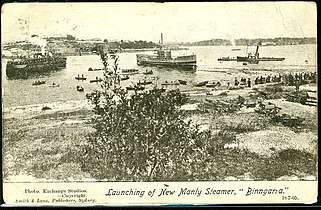 Binngarra being launched, with her forerunner, Kuring-gai, on the left, 18 July 1905
Binngarra being launched, with her forerunner, Kuring-gai, on the left, 18 July 1905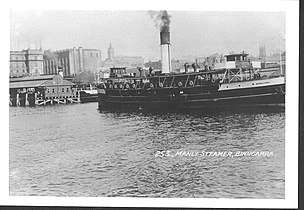 Approaching Circular Quay, 1920s
Approaching Circular Quay, 1920s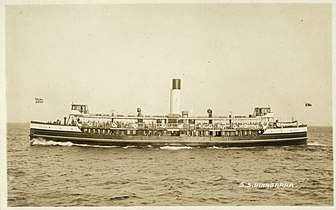 Crossing Sydney Heads
Crossing Sydney Heads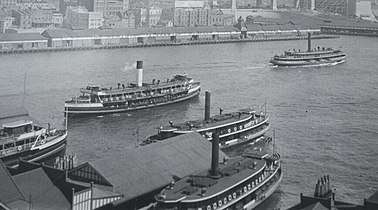 Binngarra at Circular Quay with one other Binngarra-class ferry and three K-class ferries, circa 1930
Binngarra at Circular Quay with one other Binngarra-class ferry and three K-class ferries, circa 1930
See also
References
- Manly Ferries Balgowlah, Barrenjoey & Baragoola History Works December 2007
- Andrews, Graeme (1975). The Ferries of Sydney. A.H. & A.W. Reed Pty Ltd. ISBN 0589071726.
- Andrews, Graeme (1982). A Pictorial History of Ferries: Sydney and Surrounding Waterways. Sydney: AH & AW Reed Pty Ltd. ISBN 0589503863.
- Gunter, John (1978). Across the harbour : the story of Sydney's ferries. Rigby. ISBN 0727007157.
- Prescott, AM (1984). Sydney Ferry Fleet. Magill South Australia: Ronald H Parsons. ISBN 0909418306.
External links
